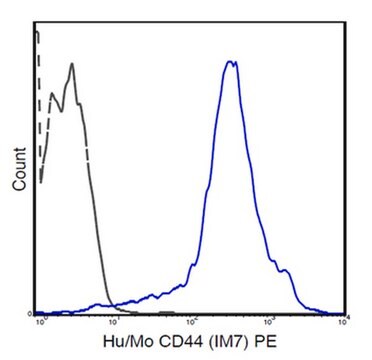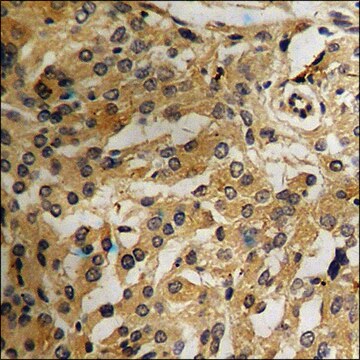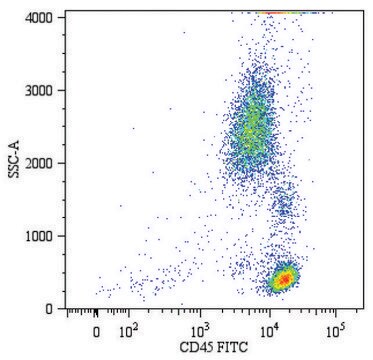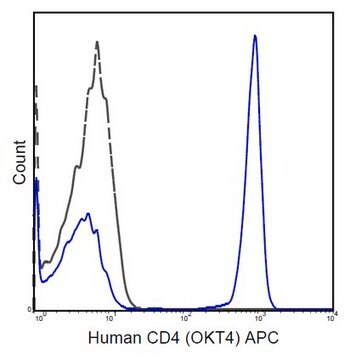推薦產品
生物源
mouse
抗體表格
purified antibody
抗體產品種類
primary antibodies
無性繁殖
mAb287, monoclonal
物種活性
mouse
包裝
antibody small pack of 25 μg
技術
ELISA: suitable
flow cytometry: suitable
inhibition assay: suitable
同型
IgG1κ
目標翻譯後修改
unmodified
基因資訊
mouse ... Ins1(16333)
一般說明
Juvenile diabetes or insulin-dependent diabetes mellitus (IDDM) is considered as an autoimmune disease where islet infiltration of T cells, B cells, macrophages, and dendritic cells leads to their progressive destruction. It is reported that non-obese diabetic mice (NOD) express a single MHC class II molecule, IAg7, which is shown to be essential for the development of IDDM. It is shown that the major T cell insulin epitope resides with in amino acids 9-23 of the beta chain (B:9-23) and this peptide can bind to IAg7 in multiple positions (registers). Pathogenic CD4 T cells can recognize beta 9-23:I Ag7 complex when the insulin peptide is bound in register 3 (R3), which places amino acids 14-22 of the beta chain in the core P1 to P9 position and places arginine at P9 position, which is highly unfavored for the IAg7 pocket. The binding motifs of IAg7 are degenerate and contain small hydrophobic residues at P4 and P6 position. This monoclonal antibody (clone mAb287) selectively binds to B:9-23 when presented by IAg7 only in R3. It blocks the binding of IAg7-B:10-23 R3 tetramers to cognate T cells and impedes T cell responses to soluble B:9-23 peptides, but does not affect recognition of any other peptide bound to IAg7. This antibody is also shown to diminish T cell infiltration in NOD mice, delay the development of IDDM and overt hyperglycemia. (Ref.: Stratmann, T., et al. (2000). J Immunol. 165(6); 3214-3225; Zhang, L., et al. (2014). Proc. Natl. Acad. Sci. USA. 111 (7); 2656-2661).
特異性
Clone mAb287 is a mouse monoclonal antibody that recognizes a molecular complex of mouse MHC class II (named I-Ag7) and a peptide derived from insulin B-chain, amino acids 9-22.
免疫原
Soluble I-Ag7 bearing Insulin R3 peptides.
應用
Anti-insulin peptide MHC, clone mAb287, Cat. No. MABF2117, is a mouse monoclonal antibody that detects Insulin peptide -MHC and has been tested for use in ELISA, Flow Cytometry, and Inhibition assay.
Flow Cytometry Analysis: A representative lot detected insulin peptide MHC in Flow Cytometry applications (Zhang, L., et. al. (2014). Proc Natl Acad Sci USA. 111(7):2656-61).
ELISA Analysis: A representative lot detected insulin peptide MHC in ELISA applications (Zhang, L., et. al. (2014). Proc Natl Acad Sci USA. 111(7):2656-61).
Inhibition Analysis: A representative lot of this antibody inhibited in vitro responses of insulin-specific T-cell hybridomas/transfectomas. (Zhang, L., et. al. (2014). Proc Natl Acad Sci USA. 111(7):2656-61).
ELISA Analysis: A representative lot detected insulin peptide MHC in ELISA applications (Zhang, L., et. al. (2014). Proc Natl Acad Sci USA. 111(7):2656-61).
Inhibition Analysis: A representative lot of this antibody inhibited in vitro responses of insulin-specific T-cell hybridomas/transfectomas. (Zhang, L., et. al. (2014). Proc Natl Acad Sci USA. 111(7):2656-61).
Research Category
Signaling
Signaling
品質
Evaluated by Isotype testing,
外觀
Protein G purified
Format: Purified
Purified mouse monoclonal antibody IgG1 in PBS without preservatives.
儲存和穩定性
Stable for 1 year at -20°C from date of receipt. Handling Recommendations: Upon receipt and prior to removing the cap, centrifuge the vial and gently mix the solution. Aliquot into microcentrifuge tubes and store at -20°C. Avoid repeated freeze/thaw cycles, which may damage IgG and affect product performance.
其他說明
Concentration: Please refer to lot specific datasheet.
免責聲明
Unless otherwise stated in our catalog or other company documentation accompanying the product(s), our products are intended for research use only and are not to be used for any other purpose, which includes but is not limited to, unauthorized commercial uses, in vitro diagnostic uses, ex vivo or in vivo therapeutic uses or any type of consumption or application to humans or animals.
未找到適合的產品?
試用我們的產品選擇工具.
分析證明 (COA)
輸入產品批次/批號來搜索 分析證明 (COA)。在產品’s標籤上找到批次和批號,寫有 ‘Lot’或‘Batch’.。
Pimploy Rattanaamnuaychai et al.
Heliyon, 6(9), e04951-e04951 (2020-10-01)
β-cell dedifferentiation has been accounted as one of the major mechanisms for β-cell failure; thus, is a cause to diabetes. We study direct impacts of liraglutide treatment on ex vivo human dedifferentiated islets, and its effects on genes important in
我們的科學家團隊在所有研究領域都有豐富的經驗,包括生命科學、材料科學、化學合成、色譜、分析等.
聯絡技術服務








